The idea of creating all the content that a social marketer needs can feel overwhelming. But it doesn’t have to feel that way. Let’s break down some of the things that you should consider when developing content for social media.
The big thing that you’ll want to do is to think about your overarching content strategy, which should be based on specific social media goals. When piecing together your content strategy, it is important to develop a social media calendar to track and organize your social posts across different channels.
Content across the social channels should vary in a few different ways. Ideally, you’ll want to optimize your content for each specific channel. To do that, it’s helpful to think in terms of campaigns. That way, you’re tying every post back to a bigger marketing goal, with the idea of developing similar, related assets to use on different channels, without posting identical posts on each channel.
As an example, Chiquita Banana did a multi-channel campaign for the 2017 eclipse. It included live video shared on Facebook, a multitude of videos shared on YouTube and across other channels, with fun graphical treatments of bananas as eclipses shared as GIFs and images.
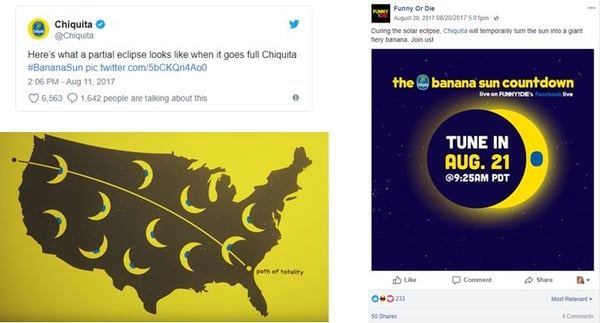
Bruno Cardinali, Head of Marketing North America at Popeyes Louisiana Kitchen tells us how he thinks about content development across social media channels:
“I think the type of content that we develop for different channels has everything to do with the audience in those channels. We tailor the content to the platform that we are engaging because of the way people consume content on those platforms. It's quite different the way people consume content on Instagram, than on Twitter, than on Facebook, and other channels. We are really careful to think about the medium we're using first, before creating the content so whatever we create is most relevant and most applicable to that specific channel.”
Want to learn how to create a social media marketing strategy for your business? Check out HubSpot Academy's free Social Media Marketing Certification and equip yourself with the knowledge and tools needed to build a social media strategy for your business.
Components to Developing Effective Social Media Content
1. Prioritize video.
Video is, by far, the most important type of content that you should be developing. According to Cisco, in 2022, online videos will make up more than 82% of all consumer internet traffic. Audio and video content are great ways to help enhance the social feed, engage more with your audience, and humanize your brand through faces and voices, not to mention video posts on social media get 48% more views. Additionally, in a 2021 Lemonlight survey, the company found that 94% of respondents shared that watching a video has helped them make a purchase decision at least once. Of those, 72% were swayed by a product demonstration video. That’s pretty powerful.
Additionally, in December 2021, TikTok surpassed Google as the most popular web domain. Sounds like pretty clear evidence that video is important, doesn’t it? And in particular, short-form video. In fact, a 2021 HubSpot poll found that 85% of marketers rank short-form videos as the most effective type of social media content.
Consider how you can use video to your advantage, whether that is featuring your company and product experts, working with influencers, highlighting customer case studies, or developing product demos to wow your customers.
Working with influencers is one way that you can take advantage of video. For example, British supermarket Waitrose teamed up with one of TikTok’s most popular food influencers, Harry Heal, @healchef, to celebrate the Christmas holiday.
@thehealchef #ad Wherever you are in the world, as long as you're surrounded with good people and good food, it's Christmas 🎄 #ChristmasatWaitrose #christmas #ad ♬ New Home - Austin Farwell
2. But don’t forget audio.
There has been a rise of interest in all things audio, particularly in the last couple of years. There are two types of audio that are seeing ongoing popularity, podcasts and live audio chat apps like Clubhouse, Twitter Spaces, Facebook’s Live Audio Rooms, Spotify’s Greenroom and the Mark Cuban-backed Fireside Chat.
According to Edison Research, 116 million people in the U.S. listened to a podcast in the last month, and 80 million are weekly podcast listeners.
Alanah Joseph, senior marketing manager for the HubSpot Podcast Network, says that one of the reasons that podcasts have become so popular is that it is easy to passively listen while you are doing other things. You can listen while you are commuting, working, cleaning the house, exercising or other activities. This also makes podcasting a great place to advertise because you have loyal listeners who are already predisposed to purchase from a host recommending a product or service.
During the pandemic, live audio services attracted millions of people stuck inside, desperate for human connection. Live audio services allow for both spontaneous and scheduled chats to take place that offer a level of listener engagement that podcasts don’t. Listeners can create open audio chat rooms, or have talks that enable listeners to be “invited on stage” to ask questions or participate.
Consider how you can take advantage of these different types of audio, whether it is pitching your execs to appear on podcasts or live audio shows, creating talks on an audio app, or even starting up your own podcast.
3. Make sure to include hashtags.
Did you know that LinchpinSEO found that Tweets with hashtags have 2 times more engagement than those without, and 55% more retweets? Hashtags are used across most platforms, but you tend to see them most on Twitter, Instagram and Tik- Tok. Hashtags are formed simply by using a word with the # symbol in front of them. They’re used to help anyone who does a search on that hashtag to easily find related content. They’re sometimes used ironically as well, and as a brand you can play with that.
Pro tip: You shouldn’t use too many hashtags. You can get away with more than two on an Instagram post, but on other platforms, try to limit to two or three at best.
Social Strategist Emilie Lewis, talked to me about her philosophy when she was a bookseller at Belmont Books:
“Hashtags matter the most on Instagram. It’s the best way that people on that platform find your posts. Of course, followers could find us, but in our case, it was usually a brand new audience potentially searching for Boston or Massachusetts. If we tagged our posts with those tags, we showed up in search. That widened our opportunity for new audience members and for new followers. The store uses some consistent tags as part of its brand. For example, they always use #ShopIndie and #ShopLocal. It's important to try and get as wide an audience as you possibly can and hashtags are really helpful with that.”
Jumping on a hashtag bandwagon is a good thing when it comes to trending topics and holidays, but make sure you have content that is relevant. Hijacking an unrelated hashtag to promote your material is spammy. Instead, tie in a product with an event that makes sense. For example, let’s say your business is a restaurant. If you know that #NationalPieDay is trending, you can share content with your audience that highlights the type of pie you make at the restaurant. It’s timely, interesting, and makes sense in the context of the hashtag as well as being relevant to your product.
Sugar, butter, pie day! In honor of #NationalPieDay, we're looking back at some of @WaitressMusical's memorable moments with the thread below! pic.twitter.com/TI5I3tYJel
— BroadwayWorld (@BroadwayWorld) January 23, 2020
4. The text you include on your posts is important to consider.
I have a few tips for using text in posts.
Check and double-check for spelling.
Make sure you are considering your brand’s voice and tone.
Think about the length of your text. On Twitter, with only 280 characters, you are forced to be brief, but in general, across all the channels, the shorter your message is the better your chances of that content being seen and reshared.
5. Include a call-to-action.
A call-to-action, or CTA, is one of the most important components of any piece of social content. True, there are times when you may not need one, particularly for awareness campaigns or on channels such as Instagram where links aren’t allowed, but in general you should think about how you can make sure a call-to-action is included in your content. This could be a link to click through to a blog post, a coupon or asking your audience to respond in some way. Keep in mind that you need to make the benefit to your followers clear. For example, if you ask them to watch a video, what will they get out of taking that action?
Your CTA should use active language. This includes words like download, like, buy, register, subscribe, donate, share, comment, secure (as in, secure your spot), and watch.
If you can make this call-to-action time-sensitive, that’s even better. We’re all familiar with these types of phrases, because they work. Some examples of time-sensitive phrases include:
-
-
- “Today Only”
- “Ends at Midnight”
- “For the next 24 Hours”
-
You’ll also want to find ways to make this CTA stand out, either visually within the graphics you use, or by highlighting the details in your hashtags and text. Make sure you include a link so you can track the CTA.
6. Tagging others in your social media content is important.
If you’re resharing content, give credit where it is due and tag the person who originally wrote it or shared it. Tagging your posts can also be beneficial to help you extend your reach if your content is in conjunction with a partner, customer, or another brand. Just make sure that when you are thinking about tagging private individuals, particularly on Facebook, that you do so with their permission. Additionally, tagging photos on Twitter to merely alert someone about the content is considered spam.
Creating Social Media Content is Easy and Affordable
Now let’s talk about developing the content itself. There are a bunch of possibilities for creating content, from creating it in-house to using a social content or social media agency.
When it comes to creating content in-house, there are a number of free or low-cost content creation tools available, like:
There’s a list of video creation tools that allow you to quickly and easily create video content, like:
Jason Hsaio, co-founder and chief video officer at Animoto, explains how easy it is to develop video content:
“Probably one of the number one questions I get is where do I start? What if I don't have content? I don't have this crazy slick studio like other big companies have. What I love to remind folks is that you probably actually have a lot of great content already. If you look on your website, if you look in your marketing materials, you've already invested in great images, probably great video clips somewhere, and you can really start leveraging that. Even stills, right? Images can be used within video. You can pair images and text to make great videos for social. But the other thing too, is honestly, the camera in your pocket, your phone, the camera on these are just as good, if not better, than a lot of professional cameras out there these days. When you think about, especially for use on the web or use on social, these screens are usually pretty tiny. We're not blowing this up to a billboard size or showing these in a theater, so the phone in your pocket is actually great.”
If you are ready to take your content development to the next level, social media agencies are also an option that you can employ to help you do everything from creating and posting content to optimizing your digital social advertising content.
Curating Content for Social Media
Curating content for your social media channels is a great way to consistently stay active on each channel with less content, demonstrate industry thought leadership, and build a community – all while saving time.
So what is content curation? Content curation means gathering content that’s relevant to a particular topic or area of interest, and then sharing it with your audience. It doesn’t mean passing off someone else’s content as your own, so make sure you’re linking back to the original author’s content and giving them credit for creating something that was so good, you wanted to share with your community.
So, why should you include content curation in your social strategy? It’s simple.
Content curation saves time and money.
You know as well as I do that creating your own content takes a lot of time. But when you turn to your community to see what they’re sharing and what they’re writing about that relates to your own business, you’ll discover an entire world of existing content and ideas that you can share on your own channels.
Content curation builds industry connections.
When you shine light on other people’s work by retweeting them and linking to their posts, you’re showing them that you appreciate their content and think it’s worthy of sharing, which is a great way to build your network.
Many brands will use curated content to highlight partnerships, awards, and community activity. This is a great way to demonstrate third-party validation for your products and services.
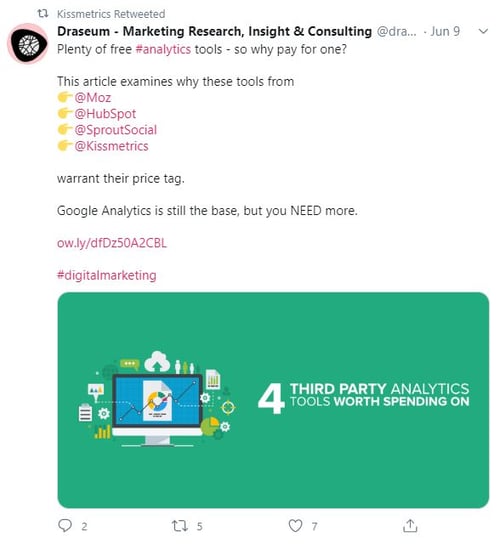
Sharing curated content also enables you to post a bigger variety of content. So let’s say your own brand tends to publish and share a lot of blog content but not as many videos. If you can curate and share some really great videos from other brands alongside your own blog posts, you’ll be giving your audience more variety so they aren’t just seeing the same types of stuff from you time and time again.
Content curation enables diversity of content.
Speaking of variety, if you’re sharing content from others, then your social feeds are going to appear more diverse to someone scrolling through. For example, if I know that your brand not only publishes quality content that you create but that you also publish helpful and knowledgeable content in the industry, then I’m going to start looking to you as someone who really knows what they are talking about. That’s right, content curation shows your diverse knowledge as a thought leader. I’ll see you as the kind of brand that posts on social to create value for your audience, not just to promote your own brand.
Content curation can take place on any platform, whether that’s creating a curated playlist of content on YouTube or sharing curated content on Facebook or Twitter. At HubSpot we took the idea of content curation one step further and created an entire network that hosts a variety of business podcasts, many of which have over a million downloads. This allows HubSpot to reference our products and services as exclusive sponsors, and to cross-reference the podcasts to grow an even bigger audience. You can check out the HubSpot podcast network here.
Coca-Cola often relies on content curation, which gives the company an ability to talk about subjects that are not specific to the world of beverages. In 2020 when the novel coronavirus pandemic first began, the brand made the decision to reshare information that would be helpful to their global audience and bring hope in what can often seem like a bleak situation.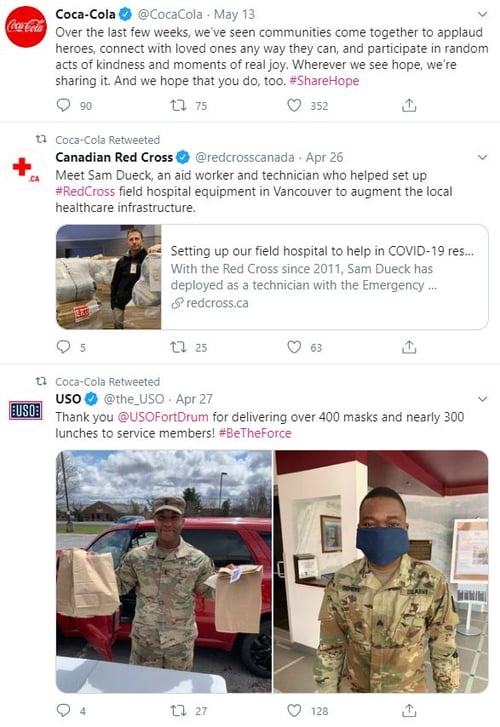
How do you curate content effectively?
First of all, make sure you establish a good mix of promotional content and curated content. People get tired of brands endlessly promoting their own products, which is exactly why progressive brands think beyond products or features. The relationship customers have with brands today goes beyond the product itself.

When you’re posting on social media, I recommend an 80/20 mix: Only 20% of your social media content should promote your own brand, and the other 80% should be dedicated to content that really, truly interests your audience and engages them in conversations. For the most part, curated content will belong in that 80%.
Try to be consistent with how many times you publish curated content versus your own content on a day-to-day basis, too.
To figure out what content you should actually curate, keep your buyer persona in mind. Which industry thought leaders do they admire? Which publications do they trust to stay up-to-date on industry news? What other brands that aren’t your direct competitors do they follow and want to hear from?
Tagging, Timing, and Testing Your Social Content
To get the best reach and results on social media, you need to do more than just creating and spreading your social content. There are three parts to your strategy that need special attention:
-
- Tagging people in social media content.
- Understanding when to post social media content.
- Experimenting with your social media content.
Tagging people in social media content.
Tagging means using a social handle or username of a person or business in your post or your photo. When you tag people or businesses in your social posts, you’re identifying them and essentially linking them in your post. Don’t confuse tagging with hashtagging, which is a way of grouping together posts that have all been hashtagged with the same words.
So why is tagging an important part of your overall strategy? When you tag a person or business in your social media posts, your post may appear on their profile page, depending on security settings. This can be a great way for your brand to get exposure to that brand or person’s audience.
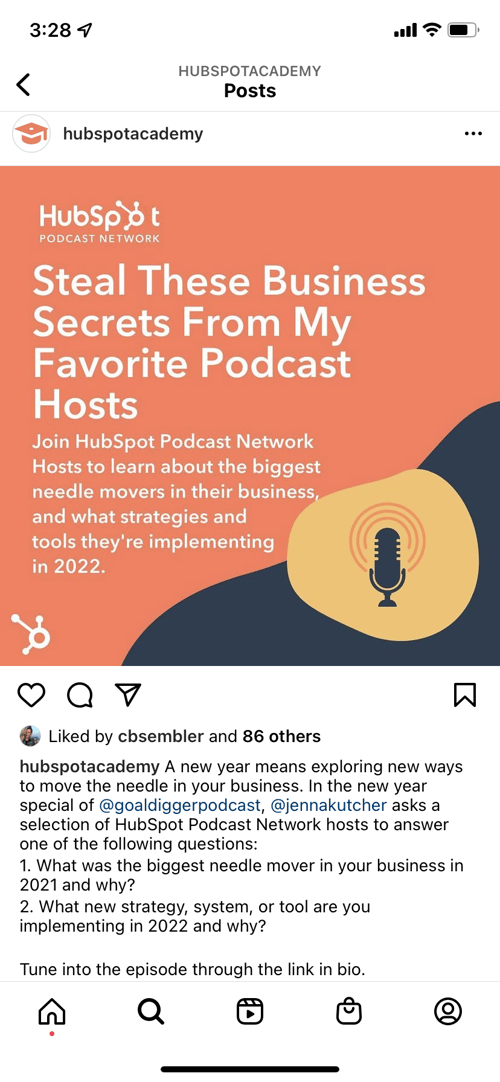
On Twitter, when you tag a person or business in a tweet, they’ll get a notification that they were mentioned. This tag won’t automatically appear on their Twitter feed, but if they retweet the tweet you tagged them in, then it will be shown to their followers, leading to more brand exposure.
When you tag a location in your Facebook and Instagram posts, then your posts will appear in the feed of that location – and people do browse location posts, especially on Instagram. Learn more on how to create an Instagram marketing strategy with this free training.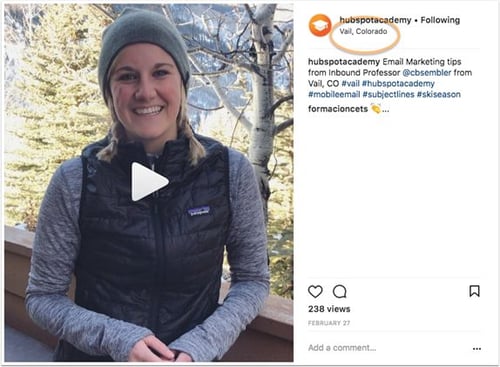
You can use tags on Facebook, LinkedIn and Pinterest now, but they aren’t as readily used as they are on other platforms. Instead, focus on using tags primarily on Instagram, TikTok, and Twitter.
To tag someone on any social media platform, simply type the “at” symbol, and then start typing the person’s or business’s profile name. When their name pops up, click on it to finish tagging them.
Understanding when to post social media content.
When should you post on different social media channels? How often should you post? How does timing vary depending on the network?
Unfortunately, there’s just no perfect answer to these questions. Good post timing depends on the platform you're using and how your target audience interacts with that platform. It can also depend on the regions and corresponding time zones you're targeting, and your marketing goals, like click-throughs versus shares.
What I can tell you is what the data says – and there is some good data out there about the best times to post on every social network. Before you rush off to dig into the data, I want to say this: Don’t take this data as Truth with a capital T. Every social platform audience is different – test to see what works best with your audience.
Pro tip: If you’re posting the same content across different channels, make sure you consciously stagger the times and days so you don’t max out your audience with a single piece of content.
Experimenting with your social media content.
It’s so, so important to test and tweak your content and posting times to figure out the best results for your business. I’ve laid out some great best practices here, but you can never know for sure which social media tactics are going to deliver results for you.
Over time, you’ll learn which social networks your audience favors, which post types that they engage with and respond to the most, which post timing and frequency fits best with their schedule, and how they prefer you engage with them.
As you test and tweak your content strategy on social, always keep your business goals in mind. There are a lot of metrics you could be measuring on social, from follower count and reach to engagement rate and response rate. But remember that at the end of the day, metrics like reach and engagement should be strategic and aimed at helping you hit your business goals, like
-
- How is your social media presence driving brand awareness?
- How is it improving traffic to your website?
- How is it helping move your leads through the buyer’s journey?
I hope this helps guide you as you not only create great social media content, but also expand your reach and get the most out of your content with tagging, timing, and testing.
For more on social media marketing courses and helpful, relevant content, visit HubSpot Academy. And for more from HubSpot’s Alanah Joseph, check out her session, “Amplified Marketing: Why and How Brands Are Amplifying Voices of Creators,” from Casted’s recent Amplify event.

